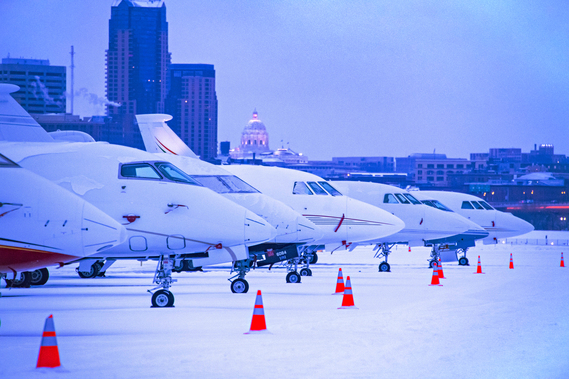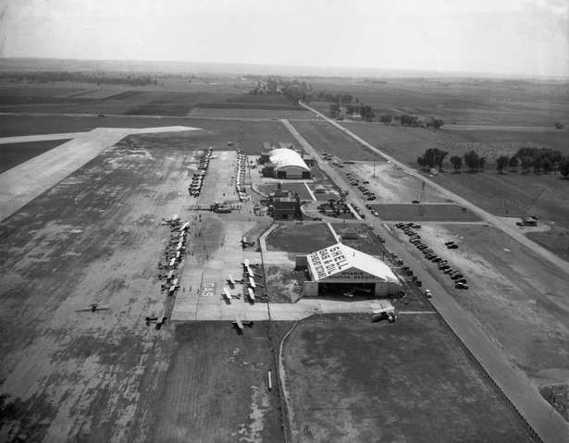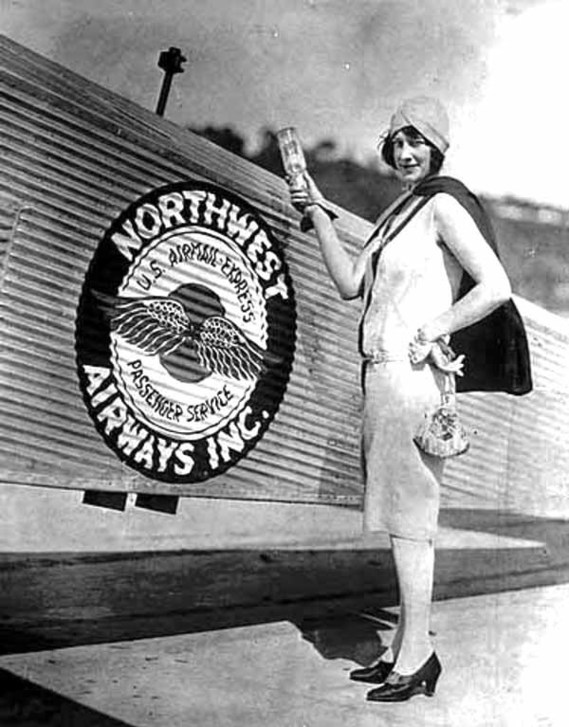|
The Downtown St. Paul Airport is already a big draw for
aircraft, and its sights are set on increased foot traffic in 2018, as new
outdoor amenities say goodbye to the snow this spring.
Recent work near the airport’s terminal included expanded
vehicle parking and a paved route to the stairs leading down to the historic
seaplane base on the Mississippi River.
“We were never able to unveil it because we worked up to the
time the snow flew,” said Joe Harris, the airport’s manager. “But when the snow
melts, it’s ready to welcome visitors.”
A floodwall project in 2008 included the reconstruction of
the stairs, part of an agreement with the city and environmental groups. “They
wanted to see some of the airport’s history brought out in the project,” Harris
said.
 Private planes parked at the Downtown St. Paul Airport during Super Bowl 52.
The floodwall, which ended the threat of springtime floodwaters bringing airport operations to a halt, has also sparked renewed interest in the airport from corporate fliers, as year-round access to the airfield was secured.
Construction of two new corporate hangars is set to get underway this year.
A public viewing area for the airfield, adjacent to the main terminal, is also expected to draw a crowd once the weather turns. “We want to hit the ground running with these public assets,” Harris said.
The airport, named for Charles “Speed” Holman – a barnstormer who was also Northwest Airline’s first pilot – sees more than 40,000 private aircraft takeoffs and landings each year. And it was a major draw for private aircraft during the Super Bowl as well, with 209 planes parked on the airfield during the game.
Because of its 6,491-foot runway, the airport can serve larger private aircraft that are capable of overseas travel from St. Paul without refueling.
Also, the airport’s newest amenity – Holman’s Table restaurant and bar -- is off to a strong start, Harris said. The restaurant opened in January, just before the Super Bowl.
 While winter is a tough time of year to open a restaurant, Harris said, Holman’s Table was boosted by the Super Bowl and has maintained momentum. The week that included Valentine’s Day was its busiest yet, and the customer count is up.
The airport community and local businesses have fueled weekday traffic, and weekend visitors are largely a non-aviation crowd wanting to see the latest dining option just across the Mississippi from downtown St. Paul. The restaurant also has a patio overlooking the airfield, which is ready for some spring sun as well.
Pictured: The airport's historic terminal, built in 1939.
The diners drawn to the airport by Holman’s table also led to an individual’s interest in leasing space in the terminal building. Recently, a new executive leadership training business opened on the terminal’s second floor, which in turn is alerting those trainees to Holman’s Table, Harris said.
Nearly 90 corporate aircraft are based at the St. Paul airport. But one former cargo airliner that sits on the east side of the airfield captures attention from visitors.
The Learning Jet, a Boeing 727 that formerly hauled cargo for Federal Express, is used by the Minnesota Association of Women in Aviation as a venue for teaching area students about aviation-related careers and fields that are supported by science, technology, engineering and math.
Last fall, renovation began on a vacant hangar owned by the Metropolitan Airports Commission near The Learning Jet, converting the hangar into classroom space. Donations of hundreds of worker hours from St. Paul-area union trade groups and contractors provided the labor to transform the hangar, which is getting close to completion.
About 2,500 students visited the jet last year, and organizers expect the number to increase in 2018.
|
(Editor’s note:
Following is the first in the series of articles regarding how the Metropolitan
Airports Commission came into being 75 years ago, and how the commission’s
airport system has evolved over the decades.)
The Metropolitan Airports Commission (MAC) marks its 75th
anniversary this year, but the idea of creating a single government entity to
own and operate Twin Cities’ airports only came about with some diplomacy following
years of spirited competition.
Long before the MAC became the airport’s owner and operator,
air travel in the Twin Cities went through a series of boom-and-partial-bust
periods. The Roaring 20s, the Great Depression and the build-up to World War II
all influenced the growth of what is now Minneapolis-St. Paul International
Airport (MSP). Out of those years emerged the need to develop one primary
airport for the metropolitan area and to create a governing board to promote
the growth of aviation in the Twin Cities. But getting there was more a process
than a straight path.
Here’s how it began.
MSP traces its roots to the demise of the Twin Cities Motor
Speedway, which operated on the airport site starting in 1915. The Speedway
went bankrupt in 1917 after a brief two-year run, and civic leaders saw an
opportunity for a new landing strip to attract more airmail service.
 Wold-Chamberlain Field in the 1920s.
Speedway Field later was renamed Wold-Chamberlain Field to honor two Minneapolis-born aviators killed in World War 1. Wold-Chamberlain Field over the next decade developed on that 160-acre parcel and grew along with an airmail route to Chicago.
During the prosperity of the 1920s, airfield use continued to grow, and Northwest Airlines -- whose acquirer Delta Air Lines still is the largest air carrier at MSP -- formed in 1926 as Northwest Airways.
Col. Lewis Brittin, Northwest’s founder, based the company at Wold-Chamberlain and won the contract for airmail service to Chicago with support from Henry Ford, the automotive industry pioneer.
Both Minneapolis and St. Paul had a hand in the operation of Wold-Chamberlain in the early years. In 1926, the city of St. Paul pulled out of its participation at Wold-Chamberlain and worked to develop an airfield closer to its core downtown area. It was thought having its own airport near the city center would give St. Paul businesses a competitive edge.
Holman Field, across the Mississippi River from downtown, would become a major draw for airmail and airline service. The competition between the two airports would later contribute to the formation of the MAC.
 A christening of a Northwest Airways plane in the late 1920s.
Northwest’s first passenger flight occurred on July 5, 1927, with service from St. Paul to Chicago. A one-way ticket cost $50, which adjusted for inflation would be $708 today. The flight took 12.5 hours with stops in La Crosse, Madison and Milwaukee.
St. Paul’s withdrawal from Wold-Chamberlain created a need to change management of that airport. The Minneapolis Park Board was the only municipal agency that had authority to buy land outside the city limits and was seen as the best choice to operate the airport.
The Park Board bought the airfield for $165,000 in 1928, as the 9th Naval District was announcing plans to establish an air squadron at Wold-Chamberlain. That and other military-related developments at the airfield would influence MSP’s fast growth during World War II.
During the late 1920s, each of the Twin Cities’ two primary airports continued to grow its own base of business. In the summer of 1929, statistics from a one-week period in July showed Holman Field with 82 airline operations and Wold-Chamberlain with 96.
Wold-Chamberlain also had 307 sightseeing operations that same week. The sight-seeing trips typically lasted 7 to 15 minutes and cost $1 or $2.
Air carriers handled the two Twin Cities’ airports differently. Some air carriers served one airport or the other. Northwest and a few others tried to serve both.
The U.S. Postal Service also decided in 1937 that airmail stops would alternate between Wold-Chamberlain and Holman Field -- if the St. Paul airfield was improved.
Locally, the competition was seen as healthy. In the bigger picture of national aviation, though, some local leaders believed the Twin Cities were hurting their ability to lure more air service and business.
 A Northwest Lockheed aircraft at Wold-Chamberlain Field, mid-1930s.
In the summer of 1937, the Minneapolis Star reported that the present Wold-Chamberlain facilities “are admittedly taxed to near capacity.” Both Northwest Airlines and Hanford Airlines, which hauled airmail, operated at the airfield. Airport managers made plans for land purchases south of the existing airfield.
Ideas were floated in the early 1940s regarding how to enable airport growth once World War II ended, and a committee formed by the Park Board recommended having one joint airport for the Twin Cities.
“(Wold-Chamberlain) is nearly equidistant from the loop districts of Minneapolis and St. Paul and the running time from each of the loop districts to and from the airport is substantially the same,” the committee noted. “In its enlarged aspect it can adequately serve both cities.”
That led to a legislative proposal to authorize “first-class” cities to issue up to $3 million in bonds for airports.
As the legislative will to help establish airports grew stronger, area leaders looked for a way to unify the Twin Cities and the surrounding metro area behind one primary airport property.
Next month: How Harold Stassen’s idea of an airport commission went from concept to reality.
Sources of information: “America’s North Coast Gateway, Minneapolis-St. Paul International Airport,” Karl Bremer, 1993.
Various Wold-Chamberlain Field annual reports and documents, Minnesota Historical Society Collection.
Minneapolis Tribune and Minneapolis Journal Star articles from the 1920s and 1930s.
Board Meetings
Business Opportunities
Career Opportunities
General Aviation Airport Information
MSP Aircraft Noise Information
MSP Airport
|